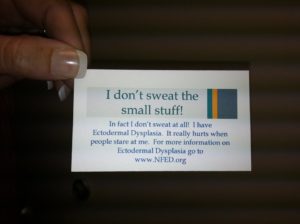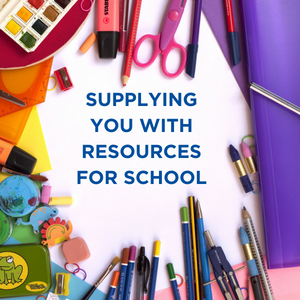 Summer is winding down in the United States. Families are sending their children back to school or are preparing to do so. If your child is affected by ectodermal dysplasia, your to-do list to get ready likely has more on it than buying school supplies! We pulled together some resources to help you advocate for your child at school. Like you, we want your child to have a positive experience in school and be successful.
Summer is winding down in the United States. Families are sending their children back to school or are preparing to do so. If your child is affected by ectodermal dysplasia, your to-do list to get ready likely has more on it than buying school supplies! We pulled together some resources to help you advocate for your child at school. Like you, we want your child to have a positive experience in school and be successful.
Educate the Teachers and Administration
Start by checking out our School Packet which has great information, sample letters and other resources.
It’s important to share information about your child and ectodermal dysplasia with the school staff, including the principal, nurse and teachers. You don’t want to assume that they know. Even if it’s not your child’s first year in the school, it’s always helpful to contact the staff and provide information to refresh their memory. Indicate any changes in your child’s symptoms or treatments that may happened since the last school year. We have a sample letter in our school packet that you can use to send to the educators.
You can also find a letter from our executive director which provides general information about the ectodermal dysplasias and potential concerns for the classroom. If your child cannot sweat due to ectodermal dysplasia, there is also a sample letter you can use to share information with any coaches if your child plays sports or PE teachers.
Meredeith Grimes, mom of a son with ectodermal dysplasia, shared her approach.
“At school, we set a meeting and talked to the principal, school nurse, and his teacher. We came up with some ways Carter could handle what he felt without drawing attention to himself. On the playground, there was one spot that has a water bottle and spray bottle for him, but if that wasn’t enough he had permission to go back into the building and go sit in the office. Our administration has been amazing, very proactive. They educated the entire staff about Carter-what to look for and how to help him. Now he’s in middle school and we put more responsibility on him to handle his symptoms by providing water bottles and cooling towels. The lunch lady at the middle school is a friend of ours and has told Carter if he’s too hot to go see her and he can stand in the cooler for awhile. We joke about it but it’s another option for him.
Valerie Montgomery is another mom who makes sure her kids’ teachers understand her children’s cooling needs.
“I provide a typed handout for the teacher that explains that the kiddo doesn’t sweat and why that matters. I include a section for outside play needs and a section on how to cool him or her down if they overheat. I keep it very simple and easy to read. I have found that a classmate will usually remind them if they forget their cooling tools before they head outside. This has worked well for my son and my daughter. I have found that the wet hat and water bottle for drinking or spraying works great at schoo!. However, my son also takes a soaking wet dish towel in his bag because he needs it when standing out in the car pickup line around his neck.”
Federal Special Education Laws – IEPs and 504 Plans
In the United States, there are special laws (both state and federal) governing special education services for children. You can learn more about these laws and the services they can provide your child in our school packet. It talks about whether your child might need an Individual Education Plan or a 504 Plan.
A 504 plan is a legal document falling under the provisions of the Rehabilitation Act of 1973. It is designed to plan a program of instructional services to assist students with special needs who are in a regular education setting. A 504 plan also provides accommodations for children affected by chronic illness. You can see a sample 504 plan for ectodermal dysplasia to better understand what such a plan looks likes and whether or not your child could benefit from one.
DOWNLOAD SCHOOL PACKETEducate Your Child’s Peers
Sharing some information about your child and ectodermal dysplasia with classmates is a great idea. You can explain it in a proactive way and allow others to ask questions. How to best do that will depend on the age of your child and what he or she is comfortable with.
For younger children, many parents have used M&Ms to teach about ectodermal dysplasia to talk about how we are all different on the outside but similar on the inside. Other parents have read the NFED’s children’s book, Lionel Learns What Matters Most, to their child’s classroom. It’s a beautiful story of a lion who has doesn’t have a bush mane, claws or sharp teeth and has to cool off in the shade. But, he finds friendship and learns that it’s what’s on his insides that matters most of all. Either of these approaches is a great way to have a conversation and let the kids ask questions.
Older children may wish to address their classmates themselves. This article will help you formulate what your child can tell their peers about ectodermal dysplasia. It helps you as a parent develop a plan with your child on what to say to peers about ectodermal dysplasia and how to do it.

Josh Sandy was 10 years old when he started feeling down about himself at school, But that all changed when he decided to give a speech to his class during Ectodermal Dysplasias Awareness Month. The result? He was empowered and his confidence soared.

By junior high or high school, your student may not want to stand in front of their peers to talk about their condition. They may find it helpful to create a small business card which they can give to teachers or to other kids who may say something to them.
Gina Quintanar made this card for her son, Alex, and found them to be a great way to address the situation and empower her son. You can write a message of your choosing. Include the link, nfed.org, so they can learn more about it.
Bullying
We know that bullying can be a serious issue for kids in school. If your child is on the receiving end of bullying, we have some resources to help you on how to respond to bullying and five steps to take to DEBUG the bullies. Both of these articles provide links to other resources about bullying.
School Advocacy Webinar
At our 2017 Family Conference, we taped our School Advocacy session led by Erin Hurley and NFED mom, Kristin Matus-Kelso. Watch this session to learn more about how to advocate and some great practical tips on what to say and do. To access the video, just fill out this form.
WATCH SCHOOL ADVOCACY VIDEOThere’s a lot to think about as a parent when it comes to your child’s school experience. Hopefully, our tips and resources here will get you and your child started on a great school year.
We’d love to hear what you are doing this year to advocate for your child at school or what you did in the past that worked well. Respond in the comments below so we can all learn.
To all of our students, young and old, good luck on your school year ahead. Shine bright!
